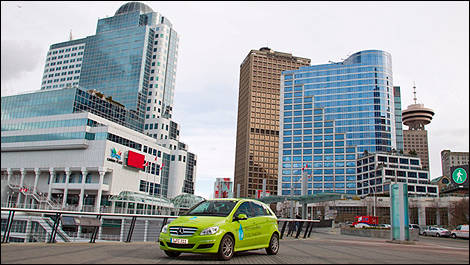Those of us waiting for a zero-emissions vehicle to hit the mass market may not have to wait too much longer. Auto makers reinforced their commitment to producing hydrogen-fuelled automobiles at the Hydrogen and Fuel Cells 2011 conference in Vancouver, BC. There’s a bit of a catch, though.
The chicken and egg scenario kept coming up to describe the current situation in regards to adopting hydrogen fuel. What comes first: the hydrogen-fuelled vehicles, or the fuelling stations? After all, consumers won’t buy the car if they don’t have access to the fuel it needs. It seems like a question of who is willing to take the first step.
Manufacturers have strong incentives for rolling out hydrogen-powered vehicles. Changing economic conditions are set to result in higher demand for private vehicles. As the standard of living improves in third-world countries, namely India and China, more and more people will be looking to buy their own personal vehicles – and the fuel to run them.
The rising cost of fossil fuel has consumers eyeing vehicles that use cheaper alternatives. Japan, which has seen its oil costs triple since 2000, is looking for a less-expensive, more sustainable option. And while it has to ship in almost all its fossil fuel, it can produce hydrogen fuel on home soil.
At the same time, governments worldwide are seeking to reduce their CO2 emissions to meet their Kyoto Protocol targets. The city of London, England, which has set a goal of reducing its emissions 60 percent by the year 2025, has introduced a fleet of eight hydrogen-powered busses. The objective by 2012 is to have a network of at least six hydrogen fuelling stations located in the London area, for both private and commercial vehicles.
Speaking at the conference, General Motors Executive Director of Fuel Cell Activities Charles Freese pointed out that the shift to a new power source has been achieved before – namely when we switched from the horse-drawn carriage to the automobile. The same hurdles existed then, not only a scarcity of fuelling stations but also a lack of roadway systems. It wasn’t until 1956 that Dwight Eisenhower committed to the creation of an interstate highway system.
Despite the present lack of fuelling infrastructure, hydrogen-fuelled vehicle technology continues to evolve and improve. Hyundai and GM have each tested their latest hydrogen models on round-the-world odysseys to test performance in all weather systems and road conditions.
The current models have managed to reduce vehicle weight, increase fuel efficiency and address problems with cold climate starting. They have an approximate range of 400 km per tank and a refill in minutes. For long-distance trips, these features put them ahead of electrical-powered vehicles which are more suitable for city driving and require several hours to recharge.
The chicken and egg scenario kept coming up to describe the current situation in regards to adopting hydrogen fuel. What comes first: the hydrogen-fuelled vehicles, or the fuelling stations? After all, consumers won’t buy the car if they don’t have access to the fuel it needs. It seems like a question of who is willing to take the first step.
Manufacturers have strong incentives for rolling out hydrogen-powered vehicles. Changing economic conditions are set to result in higher demand for private vehicles. As the standard of living improves in third-world countries, namely India and China, more and more people will be looking to buy their own personal vehicles – and the fuel to run them.
 |
| Photo: Mercedes-Benz Canada |
The rising cost of fossil fuel has consumers eyeing vehicles that use cheaper alternatives. Japan, which has seen its oil costs triple since 2000, is looking for a less-expensive, more sustainable option. And while it has to ship in almost all its fossil fuel, it can produce hydrogen fuel on home soil.
At the same time, governments worldwide are seeking to reduce their CO2 emissions to meet their Kyoto Protocol targets. The city of London, England, which has set a goal of reducing its emissions 60 percent by the year 2025, has introduced a fleet of eight hydrogen-powered busses. The objective by 2012 is to have a network of at least six hydrogen fuelling stations located in the London area, for both private and commercial vehicles.
Speaking at the conference, General Motors Executive Director of Fuel Cell Activities Charles Freese pointed out that the shift to a new power source has been achieved before – namely when we switched from the horse-drawn carriage to the automobile. The same hurdles existed then, not only a scarcity of fuelling stations but also a lack of roadway systems. It wasn’t until 1956 that Dwight Eisenhower committed to the creation of an interstate highway system.
Despite the present lack of fuelling infrastructure, hydrogen-fuelled vehicle technology continues to evolve and improve. Hyundai and GM have each tested their latest hydrogen models on round-the-world odysseys to test performance in all weather systems and road conditions.
The current models have managed to reduce vehicle weight, increase fuel efficiency and address problems with cold climate starting. They have an approximate range of 400 km per tank and a refill in minutes. For long-distance trips, these features put them ahead of electrical-powered vehicles which are more suitable for city driving and require several hours to recharge.


